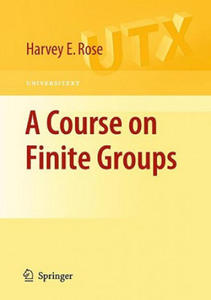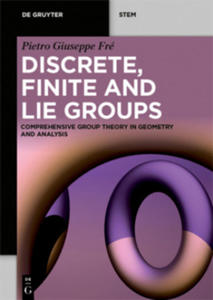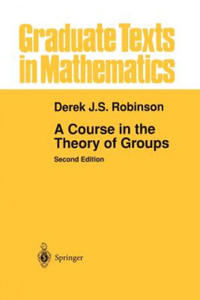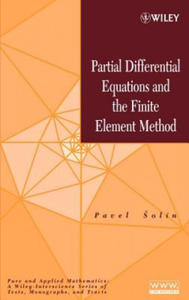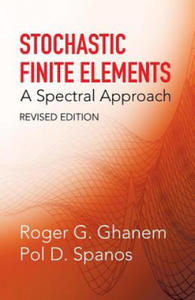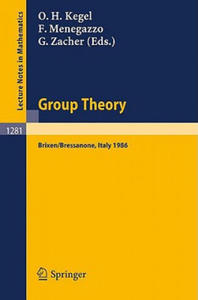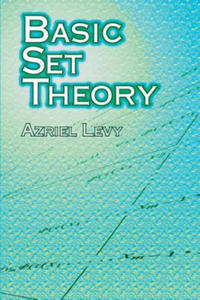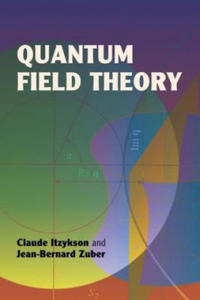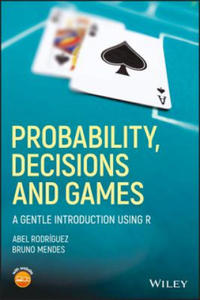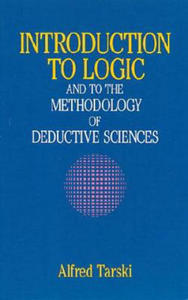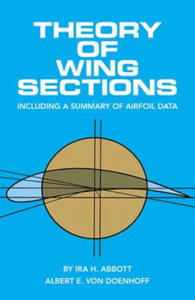krainaksiazek an introduction to the theory of groups of finite order 28313239
- znaleziono 39 produktów w 3 sklepach
An Introduction To The Theory Of Groups Of Finite Order (Classic Reprint)
Książki Obcojęzyczne>Nieprzypisane
0x0054c52a00000000
Sklep: Gigant.pl
Theory Of Groups Of Finite Order (Classic Reprint)
Książki Obcojęzyczne>Angielskie>Mathematics & science>Mathematics>AlgebraKsiążki Obcojęzyczne>Angielskie>Mathematics & science>Ma...
0x00d5c87900000000
Sklep: Gigant.pl
Course on Finite Groups SPRINGER NATURE
Książki / Literatura obcojęzyczna
A Course on Finite Groups introduces the fundamentals of group theory to advanced undergraduate and beginning graduate students. Based on a series of lecture courses developed by the author over many years, the book starts with the basic definitions and examples and develops the theory to the point where a number of classic theorems can be proved. The topics covered include: Lagrange s theorem; group constructions; homomorphisms and isomorphisms; actions; Sylow theory, products and Abelian groups; series, and nilpotent and soluble groups; and an introduction to the classification of the finite simple groups. §A number of groups are described in detail and the reader is encouraged to work with one of the many computer algebra packages available to construct and experience "actual" groups for themselves in order to develop a deeper understanding of the theory and the significance of the theorems. Numerous exercises, of varying levels of difficulty, help to test understanding.
Sklep: Libristo.pl
Discrete, Finite and Lie Groups De Gruyter
Książki / Literatura obcojęzyczna
In a self contained and exhaustive work the author covers Group Theory in its multifaceted aspects, treating its conceptual foundations in a proper logical order. First discrete and finite group theory, that includes the entire chemical-physical field of crystallography is developed self consistently, followed by the structural theory of Lie Algebras with a complete exposition of the roots and Dynkin diagrams lore.
Sklep: Libristo.pl
Course in the Theory of Groups Springer-Verlag New York Inc.
Książki / Literatura obcojęzyczna
"An excellent up-to-date introduction to the theory of groups. It is general yet comprehensive, covering various branches of group theory. The 15 chapters contain the following main topics: free groups and presentations, free products, decompositions, Abelian groups, finite permutation groups, representations of groups, finite and infinite soluble groups, group extensions, generalizations of nilpotent and soluble groups, finiteness properties." -ACTA SCIENTIARUM MATHEMATICARUM§
Sklep: Libristo.pl
Partial Differential Equations and the Finite Element Method John Wiley & Sons Inc
Książki / Literatura obcojęzyczna
A systematic introduction to partial differential equations and modern finite element methods for their efficient numerical solution Partial Differential Equations and the Finite Element Method provides a much-needed, clear, and systematic introduction to modern theory of partial differential equations (PDEs) and finite element methods (FEM). Both nodal and hierachic concepts of the FEM are examined. Reflecting the growing complexity and multiscale nature of current engineering and scientific problems, the author emphasizes higher-order finite element methods such as the spectral or hp-FEM. A solid introduction to the theory of PDEs and FEM contained in Chapters 1-4 serves as the core and foundation of the publication. Chapter 5 is devoted to modern higher-order methods for the numerical solution of ordinary differential equations (ODEs) that arise in the semidiscretization of time-dependent PDEs by the Method of Lines (MOL). Chapter 6 discusses fourth-order PDEs rooted in the bending of elastic beams and plates and approximates their solution by means of higher-order Hermite and Argyris elements.Finally, Chapter 7 introduces the reader to various PDEs governing computational electromagnetics and describes their finite element approximation, including modern higher-order edge elements for Maxwell's equations. The understanding of many theoretical and practical aspects of both PDEs and FEM requires a solid knowledge of linear algebra and elementary functional analysis, such as functions and linear operators in the Lebesgue, Hilbert, and Sobolev spaces. These topics are discussed with the help of many illustrative examples in Appendix A, which is provided as a service for those readers who need to gain the necessary background or require a refresher tutorial. Appendix B presents several finite element computations rooted in practical engineering problems and demonstrates the benefits of using higher-order FEM. Numerous finite element algorithms are written out in detail alongside implementation discussions. Exercises, including many that involve programming the FEM, are designed to assist the reader in solving typical problems in engineering and science.Specifically designed as a coursebook, this student-tested publication is geared to upper-level undergraduates and graduate students in all disciplines of computational engineeringand science. It is also a practical problem-solving reference for researchers, engineers, and physicists.
Sklep: Libristo.pl
Stochastic Finite Elements Dover Publications Inc.
Książki / Literatura obcojęzyczna
1 INTRODUCTION 1.1 Motivation 1.2 Review of Available Techniques 1.3 The Mathematical Model 1.4 Outline2 REPRESENTATION OF STOCHASTIC PROCESSES 2.1 Preliminary Remarks 2.2 Review of the Theory 2.3 Karhunen-Loeve Expansion 2.3.1 Derivation 2.3.2 Properties 2.3.3 Solution of the Integral Equation 2.4 Homogeneous Chaos 2.4.1 Preliminary Remarks 2.4.2 Definitions and Properties 2.4.3 Construction of the Polynomial Chaos3 SFEM: Response Representation 3.1 Preliminary Remarks 3.2 Deterministic Finite Elements 3.2.1 Problem Definition 3.2.2 Variational Approach 3.2.3 Galerkin Approach 3.2.4 "p-Adaptive Methods, Spectral Methods and Hierarchical Finite Element Bases" 3.3 Stochastic Finite Elements 3.3.1 Preliminary Remarks 3.3.2 Monte Carlo Simulation (MCS) 3.3.3 Perturbation Method 3.3.4 Neumann Expansion Method 3.3.5 Improved Neumann Expansion 3.3.6 Projection on the Homogeneous Chaos 3.3.7 Geometrical and Variational Extensions4 SFEM: Response Statistics 4.1 Reliability Theory Background 4.2 Statistical Moments 4.2.1 Moments and Cummulants Equations 4.2.2 Second Order Statistics 4.3 Approximation to the Probability Distribution 4.4 Reliability Index and Response Surface Simulation5 NUMERICAL EXAMPLES 5.1 Preliminary Remarks 5.2 One Dimensional Static Problem 5.2.1 Formulation 5.2.2 Results 5.3 Two Dimensional Static Problem 5.3.1 Formulation 5.3.2 Results 5.4 One Dimensional Dynamic Problem 5.4.1 Description of the Problem 5.4.2 Implementation 5.4.3 Results6 SUMMARY AND CONCLUDING REMARKS 6.1 SUMMARY AND CONCLUDING REMARKS BIBLIOGRAPHY ADDITIONAL REFERENCES INDEX
Sklep: Libristo.pl
Group Theory Springer, Berlin
Książki / Literatura obcojęzyczna
Contents: M. Barlotti: Faithful simple modules for the non-abelian group of order pq.- A. Caranti, S. Franciosi, F. de Giovanni: Some examples of infinite groups in which each element commutes with its endomorphic images.- A. Giambruno: Polynomial identities with involution and the hyperoctahedral group.- F. Gross: Automorphisms of induced extensions.- C.K. Gupta, N.D.Gupta, F. Levin: On dimension subgroups relative to certain product ideals.- B. Hartley: Centralizers in locally finite groups.- T. Hawkes: Subgroup embedding properties.- H. Heineken: Soluble irreducible groups of automorphisms of certain groups of class two.- H. Laue: On automorphism groups which normalize an abelian normal subgroup.- F. Leinen, R.E. Phillips: Algebraically closed groups in locally finite group classes.- J.C. Lennox: Soluble groups with nilpotent-extensible subgroups.- P. Longobardi, M.Maj: On the nilpotence of groups with a certain lattice of normal subgroups.- W. Möhres: Torsion-free nilpotent groups with bounded ranks of the abelian subgroups.- G. Pirillo: On permutation properties for semigroups.- D.J.S. Robinson: Vanishing theorems for cohomology of locally nilpotent groups.- R. Schmidt: Untergruppenverbände endlicher auflösbarer Gruppen.- C.M. Scoppola: An example of a nonabelian Frobenius-Wielandt complement.- S.E. Stonehewer: Subnormal subgroups of factorised groups.- J.S. Wilson: An embedding condition for subgroups of infinite groups. At the International Group Theory Conference in Bressanone recent trends and results in different areas of group theory were presented and discussed. These proceedings contain some survey articles and a number of research papers touching on a wide range of topics including permutation groups, automorphisms, presentations, products of subgroups, locally finite groups, soluble groups and related problems, with some emphasis on infinite groups.
Sklep: Libristo.pl
Course on Group Theory Dover Publications
Książki / Literatura obcojęzyczna
Preface 0 Some conventions and some basic facts 1 Introduction to finite group theory 2 Examples of groups and homomorphisms 3 "Normal subgroups, homomorphisms and quotients" 4 Group actions on sets 5 Finite p-groups and Sylow's theorem 6 Groups of even orders 7 Series 8 Direct products and the structure of finitely generated abelian groups 9 Group actions on groups 10 Transfer and splitting theorems 11 Finite nilpotent and soluble groups References Index of notation Index of subjects
Sklep: Libristo.pl
Basic Set Theory Dover Publications Inc.
Książki / Literatura obcojęzyczna
Part A. Pure Set Theory Chapter I. The Basic Notions 1. The Basic Language of Set Theory 2. The Axioms of Extensionality and Comprehension 3. Classes, Why and How 4. Classes, the formal Introduction 5. The Axioms of Set Theory 6. Relations and functions Chapter II. Order and Well-Foundedness 1. Order 2. Well-Order 3. Ordinals 4. Natural Numbers and finite Sequences 5. Well-Founded Relations 6. Well-Founded Sets 7. The Axiom of Foundation Chapter III. Cardinal Numbers 1. Finite Sets 2. The Partial Order of the Cardinals 3. The Finite Arithmetic of the Cardinals 4. The Infinite Arithmetic of the Well Orderd Cardinals Chapter IV. The Ordinals 1. Ordinal Addition and Multiplication 2. Ordinal Exponentiation 3. Cofinality and Regular Ordinals 4. Closed Unbounded Classes and Stationery Classes Chapter V. The Axiom of Choice and Some of Its Consequences 1. The Axiom of Choice and Equivalent Statements 2. Some Weaker Versions of the Axiom of Choice 3. Definable Sets 4. Set Theory with Global Choice 5. Cardinal ExponentiationPart B. Applications and Advanced Topics Chapter VI. A Review of Point Set Topology 1. Basic concepts 2. Useful Properties and Operations 3. Category, Baire and Borel Sets Chapter VII. The Real Spaces 1. The Real Numbers 2. The Separable Complete Metric Spaces 3. The Close Relationship Between the Real Numbers, the Cantor Space and the Baire Space Chapter VIII. Boolean Algebras 1. The Basic Theory 2. Prime Ideals and Representation 3. Complete Boolean Algebras 4. Martin's Axiom Chapter IX. Infinite Combinatorics and Large Cardinals 1. The Axiom of Constructibility 2. Trees 3. Partition Properties 4. Measurable CardinalsAppendix X. The Eliminability and Conservation Theorems Bibliography; Additional Bibliography; Index of Notation; IndexAppendix Corrections and Additions
Sklep: Libristo.pl
Course on Group Theory Dover Publications Inc.
Książki / Literatura obcojęzyczna
Preface0 Some conventions and some basic facts1 Introduction to finite group theory2 Examples of groups and homomorphisms3 "Normal subgroups, homomorphisms and quotients"4 Group actions on sets5 Finite p-groups and Sylow's theorem6 Groups of even orders7 Series8 Direct products and the structure of finitely generated abelian groups9 Group actions on groups10 Transfer and splitting theorems11 Finite nilpotent and soluble groups References Index of notation Index of subjects
Sklep: Libristo.pl
Quantum Field Theory Dover Publications Inc.
Książki / Literatura obcojęzyczna
PrefaceGeneral References1. Classical Theory 1.1 Principle of Least Action 1.1.1 Classical Motion 1.1.2 Electromagnetic Field as an Infinite Dynamical System 1.1.3 Electromagnetic Interaction of a Point Particle 1.2 Symmetries and Conservation Laws 1.2.1 Fundamental Invariants 1.2.2 Energy Momentum Tensor 1.2.3 Internal Symmetries 1.3 Propagation and Radiation 1.3.1 Green Functions 1.3.2 Radiation2. The Dirac Equation 2.1 Toward a Relativistic Wave Equation 2.1.1 Quantum Mechanics and Relativity 2.1.2 The Dirac Equation 2.1.3 Relativistic Covariance 2.2 Physical Content 2.2.1 Plane Wave Solutions and Projectors 2.2.2 Wave Packets 2.2.3 Electromagnetic Coupling 2.2.4 Foldy-Wouthuysen Transformation 2.3 Hydrogen-like Atoms 2.3.1 Nonrelativistic versus Relativistic Spectrum 2.3.2 Dirac Theory 2.4 Hole Theory and Charge Conjugation 2.4.1 Reinterpretation of Negative Energy Solutions 2.4.2 Charge Conjugation 2.4.3 Zero-Mass Particles 2.5 Dirac Propagator 2.5.1 Free Propagator 2.5.2 Propagation in an Arbitrary External Electromagnetic Field 2.5.3 Application to the Coulomb Scattering 2.5.4 Fock-Schwinger Proper Time Method3. Quantization--Free Fields 3.1 Canonical Quantization 3.1.1 General Formulation 3.1.2 Scalar Field 3.1.3 Charged Scalar Field 3.1.4 Time-Ordered Product 3.1.5 Thermodynamic Equilibrium 3.2 Quantized Radiation Field 3.2.1 Indefinite Metric 3.2.2 Propagator 3.2.3 Massive Vector Field 3.2.4 Vacuum Fluctuations 3.3 Dirac Field and Exclusion Principle 3.3.1 Anticommutators 3.3.2 Fock Space for Fermions 3.3.3 Relation between Spin and Statistics--Propagator 3.4 Discrete Symmetries 3.4.1 Parity 3.4.2 Charge Conjugation 3.4.3 Time Reversal 3.4.4 Summary4. Interaction with an External Field 4.1 Quantized Electromagnetic Field Interacting with a Classical Source 4.1.1 Emission Probabilities 4.1.2 Emitted Energy and the Infrared Catastrophe 4.1.3 Induced Absorption and Emission 4.1.4 S Matrix and Evolution Operator 4.2 Wick's Theorem 4.2.1 Bose Fields 4.2.2 Fermi Fields 4.2.3 General Case 4.3 Quantized Dirac Field Interacting with a Classical Potential 4.3.1 General Formalism 4.3.2 Emission Rate to Lowest Order 4.3.3 Pair Creation in a Constant Uniform Electric Field 4.3.4 The Euler-Heisenberg Effective Lagrangian5. Elementary Processes 5.1 S Matrix and Asymptotic Theory 5.1.1 Cross Sections 5.1.2 Asymptotic Theory 5.1.3 Reduction Formulas 5.1.4 Generating Functional 5.1.5 Connected Parts 5.1.6 Fermions 5.1.7 Photons 5.2 Applications 5.2.1 Compton Effect 5.2.2 Pair Annihilation 5.2.3 Positronium Lifetime 5.2.4 Bremsstrahlung 5.3 Unitarity and Causality 5.3.1 Unitarity and Partial Wave Decomposition 5.3.2 Causality and Analyticity 5.3.3 The Jost-Lehmann-Dyson Representation 5.3.4 Forward Dispersion Relations 5.3.5 Momentum Transfer Analyticity6. Perturbation Theory 6.1 Interaction Representation and Feynman Rules 6.1.1 Self-Interacting Scalar Field 6.1.2 Feynman Rules for Spinor Electrodynamics 6.1.3 Electron-Electron and Electron-Positron Scattering 6.1.4 Scalar Electrodynamics 6.2 Diagrammatics 6.2.1 Loopwise Expansion 6.2.2 Truncated and Proper Diagrams 6.2.3 Parametric Representation 6.2.4 Euclidean Green Functions 6.3 Analyticity Properties 6.3.1 Landau Equations 6.3.2 Real Singularities 6.3.3 Real Singularities of Simple Diagrams 6.3.4 Physical-Region Singularities. Cutkosky Rules7. Radiative Corrections 7.1 One-Loop Renormalization 7.1.1 Vacuum Polarization 7.1.2 Electron Propagator 7.1.3 Vertex Function 7.1.4 Summary 7.2 Radiative Corrections to the Interaction with an External Field 7.2.1 Effective Interaction and Anomalous Magnetic Moment 7.2.2 Radiative Corrections to Coulomb Scattering 7.2.3 Soft Bremsstrahlung 7.2.4 Finite Inclusive Cross Section 7.3 New Effects 7.3.1 Photon-Photon Scattering 7.3.2 Lamb Shift 7.3.3 Van der Waals Forces at Large Distances8. Renormalization 8.1 Regularization and Power Counting 8.1.1 Introduction 8.1.2 Regularization 8.1.3 Power Counting 8.1.4 Convergence Theorem 8.2 Renormalization 8.2.1 Normalization Conditions and Structure of the Counterterms 8.2.2 Bogoliubov's Recursion Formula 8.2.3 Zimmermann's Explicit Solution 8.2.4 Renormalization in Parametric Space 8.2.5 Finite Renormalizations 8.2.6 Composite Operators 8.3 Zero-Mass Limit, Asymptotic Behavior, and Weinberg's Theorem 8.3.1 Massless Theories 8.3.2 Ultraviolet Behavior and Weinberg's Theorem 8.4 The Case of Quantum Electrodynamics 8.4.1 Formal Derivation of the Ward-Takahashi Identities 8.4.2 Pauli-Villars Regularization to All Orders 8.4.3 Renormalization 8.4.4 Two-Loop Vacuum Polarization9. Functional Methods 9.1 Path Integrals 9.1.1 The Role of the Classical Action in Quantum Mechanics 9.1.2 Trajectories in the Bargmann-Fock Space 9.1.3 Fermion Systems 9.2 Relativistic Formulation 9.2.1 S Matrix and Green Functions in Terms of Path Integrals 9.2.2 Effective Action and Steepest-Descent Method 9.3 Constrained Systems 9.3.1 General Discussion 9.3.2 The Electromagnetic Field as an Example 9.4 Large Orders in Perturbation Theory 9.4.1 Introduction 9.4.2 Anharmonic Oscillator10. Integral Equations and Bound-State Problems 10.1 The Dyson-Schwinger Equations 10.1.1 Field Equations 10.1.2 Renormalization 10.2 Relativistic Bound States 10.2.1 Homogeneous Bethe-Salpeter Equation 10.2.2 The Wick Rotation 10.2.3 Scalar Massless Exchange in the Ladder Approximation&n 12.3 The Effective Action at the One-Loop Order 12.3.1 General Form 12.3.2 Two-Point Function 12.3.3 Other Functions 12.3.4 One-Loop Renormalization 12.4 Renormalization 12.4.1 Slavnov-Taylor Identities 12.4.2 Identities for Proper Functions 12.4.3 Recursive Construction of the Counterterms 12.4.4 Gauge Dependence of Green Functions 12.4.5 Anomalies 12.5 Massive Gauge Fields 12.5.1 Historical Background 12.5.2 Massive Gauge Theory 12.5.3 Spontaneous Symmetry Breaking 12.5.4 Renormalization of Spontaneously Broken Gauge 12.5.5 Gauge Independence and Unitarity of the S Matrix 12.6 The Weinberg-Salam Model 12.6.1 The Model for Leptons 12.6.2 Electron-Neutrino Cross Sections 12.6.3 Higher-Order Corrections 12.6.4 Incorporation of Hadrons13. Asymptotic Behavior 13.1 Effective Charge in Electrodynamics 13.1.1 The Gell-Mann and Low Function 13.1.2 The Callan-Symanzik Equation 13.2 Broken Scale Invariance 13.2.1 Scale and Conformal Invariance 13.2.2 Modified Ward Identities 13.2.3 Callan-Symanzik Coefficients to Lowest Order 13.3 Scale Invariance Recovered 13.3.1 Coupling Constant Flow 13.3.2 Asymptotic Freedom 13.3.3 Mass Corrections 13.4 Deep Inelastic Lepton-Hadron Scattering and Electron-Positron Annihilation into Hadrons 13.4.1 Electroproduction 13.4.2 Light-Cone Dynamics 13.4.3 Electron-Positron Annihilation 13.5 Operator Product Expansions 13.5.1 Short-Distance Expansion 13.5.2 Dominant and Subdominant Operators, Operator Mixing, and Conservation Laws 13.5.3 Light-Cone ExpansionAppendixA-1 MetricA-2 Dirac Matrices and SpinorsA-3 Normalization of States, S Matrix, Unitarity, and Cross SectionsA-4 Feynman RulesIndex
Sklep: Libristo.pl
Probability, Decisions and Games - A Gentle Introduction using R John Wiley and Sons Ltd
Książki / Literatura obcojęzyczna
Introduces the fundamentals of probability, statistics, decision theory, and game theory, and features interesting examples of games of chance to illustrate the presented mathematical conceptsRanging from simple games to strategic games, Probability, Decisions and Games features a variety of gaming and gambling examples to build a better understanding of quantitative reasoning. The authors establish fundamental concepts before moving on to more strategic games that illustrate how multiple concepts fit together. Organized into thirteen chapters, this book presents equal coverage on the general mathematical analysis concepts found in a wide variety of games as well as the specific theories and problems associated with well-known casino games. The authors cover zero-sum games, non-zero-sum games, and sequential games in order to introduce ideas such as mathematical expectation and variance, bias, combinatorial calculus, conditional probability and Bayes Theorem, Bernoulli trials, and the Binomial distribution.This book presents interesting gaming examples to highlight the practical applications and methodologies behind the basic concepts of probability, statistics, decision theory, and game theory. The first two chapters of Probability, Decisions and Games: A Gentle Introduction using R feature an introductory discussion of utility and probability theory in finite and discrete spaces. Subsequent chapters utilize popular casino games to illustrate the practical probabilistic methodologies. Finally, the book concludes with discussions on game theory and strategic games.Features introductory coverage of probability, statistics, decision theory, game theory, and mathematical analysis and has been class-tested at University of California, Santa Cruz for the past six yearsIllustrates mathematical concepts through interesting and fun examples using five popular casino games: roulette, lotto, craps, blackjack, and pokerProvides a variety of gaming and gambling examples of well-known simple games, such as casino games, zero-sum games, non-zero-sum games, and sequential games, in order to help readers better understand quantitative reasoningFeatures computer simulations using R throughout in order to illustrate complex concepts and help readers calculate the presented problemsContains exercises throughout and approaches games and gambling at a level that is accessible for readers with minimal experiencePresents a unique approach by presenting simple games first to demonstrate individual concepts before moving on to more strategic games that illustrate how these concepts work togetherProbability, Decisions and Games: A Gentle Introduction using R is a unique and helpful textbook for undergraduate courses on statistical reasoning, introduction to probability, statistical literacy, and quantitative reasoning for students from a variety of disciplines.
Sklep: Libristo.pl
Introduction to Logic Dover Publications Inc.
Książki / Literatura obcojęzyczna
PREFACEFROM THE PREFACE TO THE ORIGINAL EDITIONFIRST PART ELEMENTS OF LOGIC. DEDUCTIVE METHODI. ON THE USE OF VARIABLES 1. Constants and variables 2. Expressions containing variables-sentential and designatory functions 3. Formation of sentences by means of variables-universal and existential sentences 4. Universal and existential quantifiers; free and bound variables 5. The importance of variables in mathematics ExercisesII. ON THE SENTENTIAL CALCULUS 6. Logical constants; the old logic and the new logic 7. "Sentential calculus; negation of a sentence, conjunction and disjunction of sentences" 8. Implication or conditional sentence; implication in material meaning 9. The use of implication in mathematics 10. Equivalence of sentences 11. The formulation of definitions and its rules 12. Laws of sentential calculus 13. Symbolism of sentential calculus; truth functions and truth tables 14. Application of laws of sentential calculus in inference 15. "Rules of inference, complete proofs" ExercisesIII. ON THE THEORY OF IDENTITY 16. Logical concepts outside sentential calculus; concept of identity 17. Fundamental laws of the theory of identity 18. Identity of things and identity of their designations; use of quotation marks 19. "Equality in arithmetic and geometry, and its relation to logical identity" 20. Numerical quantifiers ExercisesIV. ON THE THEORY OF CLASSES 21. Classes and their elements 22. Classes and sentential functions with one free variable 23. Universal class and null class 24. Fundamental relations among classes 25. Operations on classes 26. "Equinumerous classes, cardinal number of a class, finite and infinite classes; arithmetic as a part of logic" ExercisesV. ON THE THEORY OF RELATIONS 27. "Relations, their domains and counter-domains; relations and sentential functions with two free variables" 28. Calculus of relations 29. Some properties of relations 30 "Relations which are reflexive, symmetrical and transitive" 31. Ordering relations; examples of other relations 32. One-many relations or functions 33. "One-one relations or biunique functions, and one-to-one correspondences" 34. Many-termed relations; functions of several variables and operations 35. The importance of logic for other sciences ExercisesVI. ON THE DEDUCTIVE METHOD 36. "Fundamental constituents of a deductive theory-primitive and defined terms, axioms and theorems" 37. Model and interpretation of a deductive theory 38. Law of deduction; formal character of deductive sciences 39. Selection of axioms and primitive terms; their independence 40. "Formalization of definitions and proofs, formalized deductive theories" 41. Consistency and completeness of a deductive theory; decision problem 42. The widened conception of the methodology of deductive sciences ExercisesSECOND PART APPLICATIONS OF LOGIC AND METHODOLOGY IN CONSTRUCTING MATHEMATICAL THEORIESVII. CONSTRUCTION OF A MATHEMATICAL THEORY: LAWS OF ORDER FOR NUMBERS 43. Primitive terms of the theory under construction; axioms concerning fundamental relations among numbers 44. Laws of irreflexivity for the fundamental relations; indirect proofs 45. Further theorems on the fundamental relations 46. Other relations among numbers ExercisesVIII. CONSTRUCTION OF A MATHEMATICAL THEORY: LAWS OF ADDITION AND SUBTRACTION 47. "Axioms concerning addition; general properties of operations, concepts of a group and of an Abelian group" 48. Commutative and associative laws for a larger number of summands 49. Laws of monotony for addition and their converses 50. Closed systems of sentences 51. Consequences of the laws of monotony 52. Definition of subtraction; inverse operations 53. Definitions whose definiendum contains the identity sign 54. Theorems on subtraction ExercisesIX. METHODOLOGICAL CONSIDERATIONS ON THE CONSTRUCTED THEORY 55. Elimination of superfluous axioms in the original axiom system 56. Independence of the axioms of the simplified system 57. Elimination of superfluous primitive terms and subsequent simplification of the axiom system; concept of an ordered Abelian group 58. Further simplification of the axiom system; possible transformations of the system of primitive terms 59. Problem of the consistency of the constructed theory 60. Problem of the completeness of the constructed theory ExercisesX. EXTENSION OF THE CONSTRUCTED THEORY. FOUNDATIONS OF ARITHMETIC OF REAL NUMBERS 61. First axiom system for the arithmetic of real numbers 62. Closer characterization of the first axiom system; its methodological advantages and didactical disadvantages 63. Second axiom system for the arithmetic of real numbers 64. Closer characterization of the second axiom system; concepts of a field and of an ordered field 65. Equipollence of the two axiom systems; methodological disadvantages and didactical advantages of the second system ExercisesSUGGESTED READINGSINDEX
Sklep: Libristo.pl
Theory of Wing Sections Dover Publications Inc.
Książki / Literatura obcojęzyczna
PREFACE TO DOVER EDITIONPREFACE1. THE SIGNIFICANCE OF WING-SECTION CHARACTERISTICS Symbols. The Forces on Wings. Effect of Aspect Ratio. Application of Section Data to Monoplane Wings: a. Basic Concepts of Lifting-line Theory. b. Solutions for Linear Lift Curves. c. Generalized Solution. Applicability of Section Data.2. SIMPLE TWO-DIMENSIONAL FLOWS Symbols. Introduction. Concept of a Perfect Fluid. Equations of Motion. Description of Flow Patterns. Simple Two-dimensional Flows: a. Uniform Stream. b. Sources and Sinks. c. Doublets. d. Circular Cylinder in a Uniform Stream. e. Vortex. f. Circular Cylinder with Circulation.3. THEORY OF WING SECTIONS OF FINITE THICKNESS Symbols. Introduction. Complex Variables. Conformal Transformations. Transformation of a Circle into a Wing Section. Flow about Arbitrary Wing Sections. Empirical Modification of the Theory. Design of Wing Sections.4. THEORY OF THIN WING SECTIONS Symbols. Basic Concepts. Angle of Zero Lift and Pitching Moment. Design of Mean Lines. Engineering Applications of Section Theory.5. THE EFFECTS OF VISCOSITY Symbols. Concept of Reynolds Number and Boundary Layer. Flow around Wing Sections. Characteristics of the Laminar Layer. Laminar Skin Friction. Momentum Relation. Laminar Separation. Turbulent Flow in Pipes. Turburlent Skin Friction. Calculation of Thickness of the Turbulent Layer. Turbulent Separation. Transition from Laminar to Turbulent Flow. Calculation of Profile Drag. Effect of Mach Number on Skin Friction.6. FAMILIES OF WING SECTIONS Symbols. Introduction. Method of Combining Mean Lines and Thickness Distributions. NACA Four-digit Wing Sections: a. Thickness Distributions. b. Mean Lines. c. Numbering System. d. Approximate Theoretical Characteristics. NACA Five-digit Wing Sections: a. Thickness Distributions. b. Mean Lines. c. Numbering System. d. Approximate Theoretical Characteristics. Modified NACA Four-and Five-digit Series Wing Sections. NACA 1-Series Wing Sections: a. Thickness Distributions. b. Mean Lines. c. Numbering System. d. Approximate Theoretical Characteristics. NACA 6-Series Wing Sections: a. Thickness Distributions. b. Mean Lines. c. Numbering System. d. Approximate Theoretical Characteristics. NACA 7-Series Wing Sections. Special Combinations of Thickness and Camber.7. EXPERIMENTAL CHARACTERISTICS OF WING SECTIONS. Symbols. Introduction. Standard Aerodynamic Characteristics. Lift Characteristics: a. Angle of Zero Lift. b. Lift-curve Slope. c. Maximum Lift. d. Effect of Surface Condition on Lift Characteristics. Drag Characteristics: a. Minimum Drag of Smooth Wing Sections. b. Variation of Profile Drag with Lift Coefficient. c. Effect of Surface Irregularities on Drag Characteristics. d. Unconservative Wing Sections. Pitching moment Characteristics.8. HIGH-LIFT DEVICES Symbols. Introduction. Plain Flaps. Split Flaps. Slotted Flaps: a. Description of Slotted Flaps. b. Single-slotted Flaps. c. External-aifoil Flaps. d. Double-slotted Flaps. Leading-edge High-lift Devices: a. Slats. b. Slots. c. Leading-edge Flaps. Boundary-layer Control. The Chordwise Load Distribution over Flapped Wing Sections.9. EFFECTS OF COMPRESSIBILITY AT SUBSONIC SPEEDS Symbols. Introduction. Steady Flow through a Stream Tube: a. Adiabatic Law b. Velocity of Sound c. Bernoulli's Equation for Compressible Flow. d. Cross-sectional Areas and Pressures in a Stream Tube. e. Relations for a Normal Shock. First-order Compressibility Effects: a. Glauert-Prandtl Rule b. Effect of Mach Number on the Pressure Coefficient. Flow about Wing Sections at High Speed: a. Flow at Subcritical Mach Numbers. b. Flow at Supercritical Mach Numbers. Experimental Wing Characteristics at High Speeds: a. Lift Characteristics. b. Drag Characteristics. c. Moment Characteristics. Wings for High-speed Applications.REFERENCESAPPENDIX I. Basic Thickness Forms II. Mean Lines III. Airfoil Ordinates IV. Aerodynamic Characteristics of Wing SectionsINDEX
Sklep: Libristo.pl
szukaj w Kangoo krainaksiazek an introduction to the theory of groups of finite order 28313239
Sklepy zlokalizowane w miastach: Warszawa, Kraków, Łódź, Wrocław, Poznań, Gdańsk, Szczecin, Bydgoszcz, Lublin, Katowice
Szukaj w sklepach lub całym serwisie
1. Sklepy z krainaksiazek pl an introduction to the theory of groups of finite order 28313239
2. Szukaj na wszystkich stronach serwisu
t1=0.16, t2=0, t3=0.002, t4=0.019, t=0.162



